On September 26, 2019, I had the opportunity to address the Michigan State University President’s Council, which includes the Deans Council and the Executive Leadership of the University, about the values-based strategic planning process we have undertaken in the College of Arts & Letters. In our ongoing effort to cultivate habits of openness, we have been consulting with colleagues and carefully considering how to most appropriately make some of the things I said that day public. I offer an account of the presentation here with the slides the College of Arts & Letters Marketing and Communications team and I developed. In order to provide a more textured sense of the thinking that informed our process and approach, I have inserted meta-reflections in italics.
As we considered the responsibility that comes with being asked to be the first College to present at the newly established President’s Council, we reflected on how best to emphasize the kind of collaboration that will be required across the University if we are to create the culture of care and accountability we need in the wake of the crisis we are experiencing. To this end, I began by returning to January 2018, to the survivor impact statements, and to the values to which my dean colleagues and I committed ourselves.
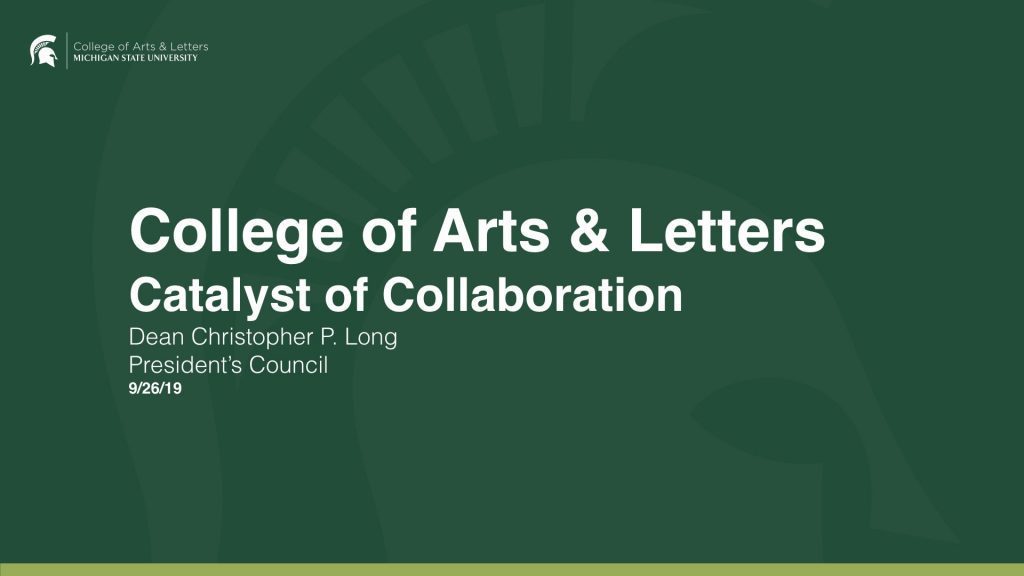
In the wake of the survivor impact statements in January 2018, the MSU deans gathered at the Residential College in the Arts and Humanities on Sunday, January. We needed to consider how to respond to the Board of Trustees who had asked to meet with us to seek our advice concerning the appointment of an interim President.
We took that opportunity to articulate a set of values to which we are committed to living out in our relationships to one another and in our leadership of the University.
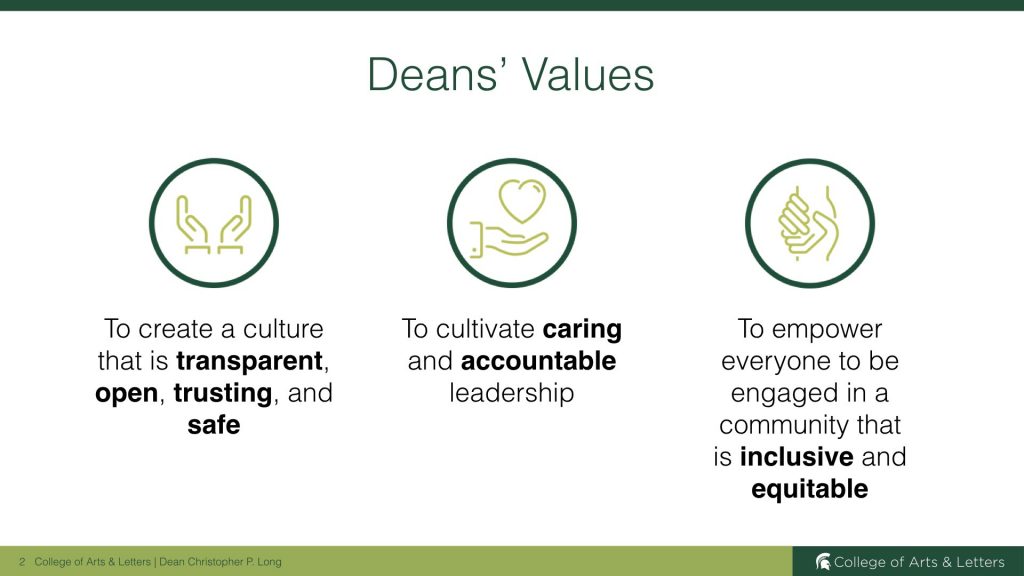
Over the course of the past year and a half, we have sought to put these values into practice during a very difficult period of the University’s history in which these values were in direct conflict with the leadership style of the interim President.
Throughout the year, every morning of each day, in fact, I have returned to this quotation from James Baldwin’s The Price of the Ticket in an attempt to hold my own leadership practice accountable to the values we’d articulated and affirmed that Sunday afternoon in January 2018.

This injunction to live out the values to which we say we are committed informed the values-based strategic planning process we undertook in the Fall of 2018 in the College of Arts & Letters.
All departments, programs, and centers were asked to facilitate open and candid conversations to identify the top three core values of the unit. In their Fall 2018 planning letters, unit leaders were asked to articulate those values and identify the three or four initiatives through which they were putting those values into practice in the teaching, research, creative activity, and outreach endeavor they were committed to undertake. Here is a word cloud that captures some of the top values that emerged from those discussions.

This process led us to identify the three core values of the College of Arts & Letters at Michigan State University: Equity, Openness, and Community. We developed a list of subcategories to lend determination to the core values.
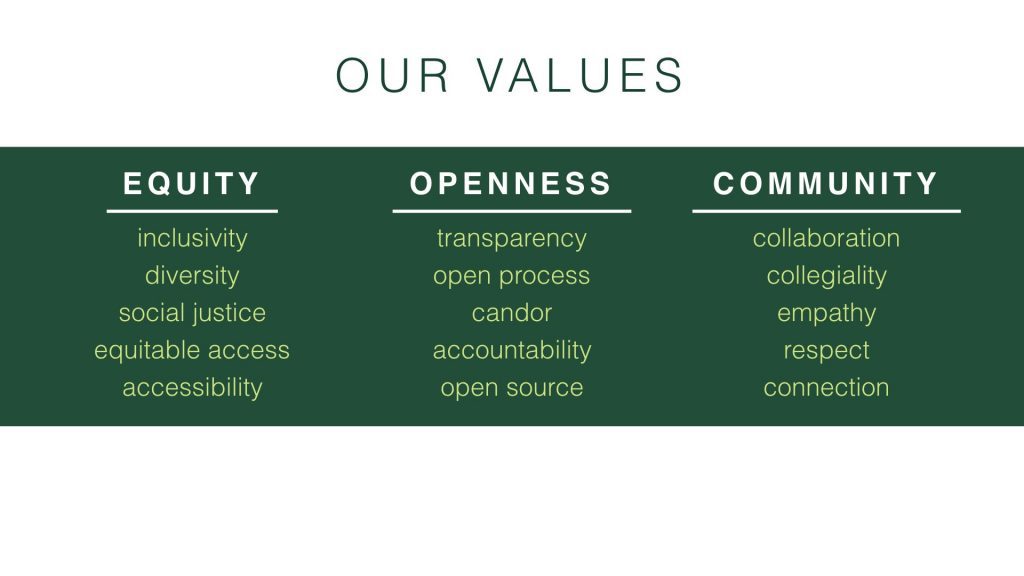
We are committed to putting these values into practice in pursuit of our top three priorities.

Our intentional efforts to put our values into practice in our interactions with one another, in each decision we make, and in the policies we adopt are motivated by the belief that if we create a culture of care in which values are identified, discussed, and practiced in spaces that are open, trusting, and safe, we will become a magnet for students and faculty committed to doing innovative, intersectional, and meaningful work.
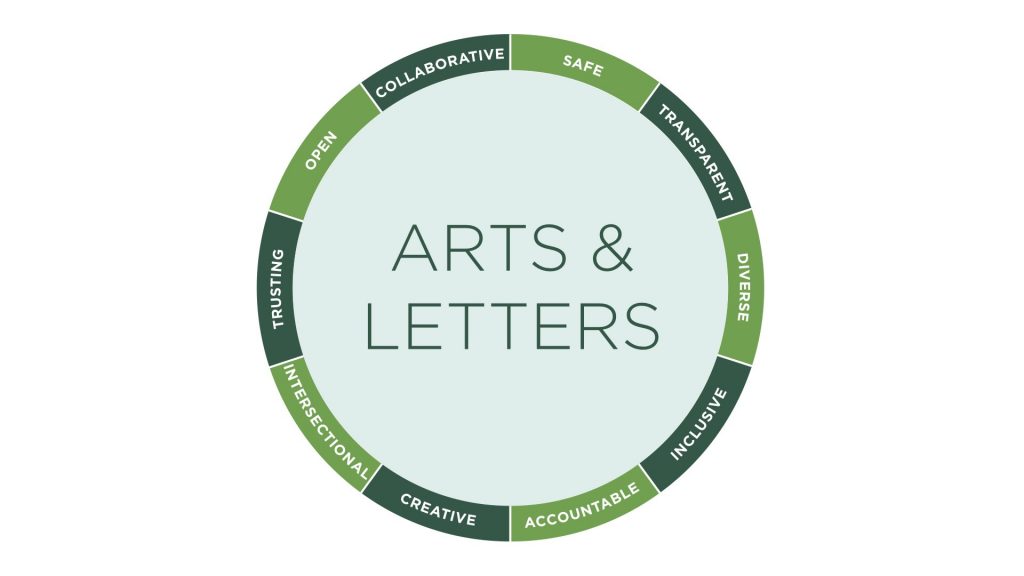
By nurturing a culture of care, we hope to embody a model for higher education that measures up to the values for which we advocate. At the heart of this effort are practices of critical self-reflection that require us to be candid with ourselves about our strengths, weaknesses, threats, and opportunities.
By framing the presentation this way, we hoped to show how the College of Arts & Letters is modeling the sort of values-based culture change the University needs without centering the College in a way that contributes to a climate of competition that fails to recognize the degree to which our strengths lie in partnerships rooted in trust. In turning to a more traditional SWOT approach, I was concerned about becoming self-centered in ways that are exclusionary. To redress this, we tried to emphasize the network of connections that make the strengths that have emerged possible.
Strengths
While it’s possible to emphasize more than four areas in which the College of Arts & Letters at Michigan State University is strong, these four come ultimately down to one fundamental commitment — to be a catalyst of collaboration so that the arts and humanities are woven deeply into the fabric of our communities on campus and off.
This image attempts to capture both four current strengths of the College — Digital Humanities, Arts & Intermedia, Diversity Studies, and Health & Bioethics — and the collaboration that is the condition for the possibility for these and other emerging strengths.

In identifying these areas as strengths, we do not mean to imply that these are the only things we do well nor that those colleges appearing here are the only partners with whom we are engaged. Rather, these are areas in which we have an established reputation of national and international leadership. More importantly, these are not strengths of the College of Arts & Letters in isolation from the rich nexus of relationships we have with our partners in other colleges and units across the University.
Our core strength lies in our capacity to be a catalyst of collaboration.
If equity is a shared core value of the College of Arts & Letters, we need to integrate a commitment to diversity into the intellectual life of the College.
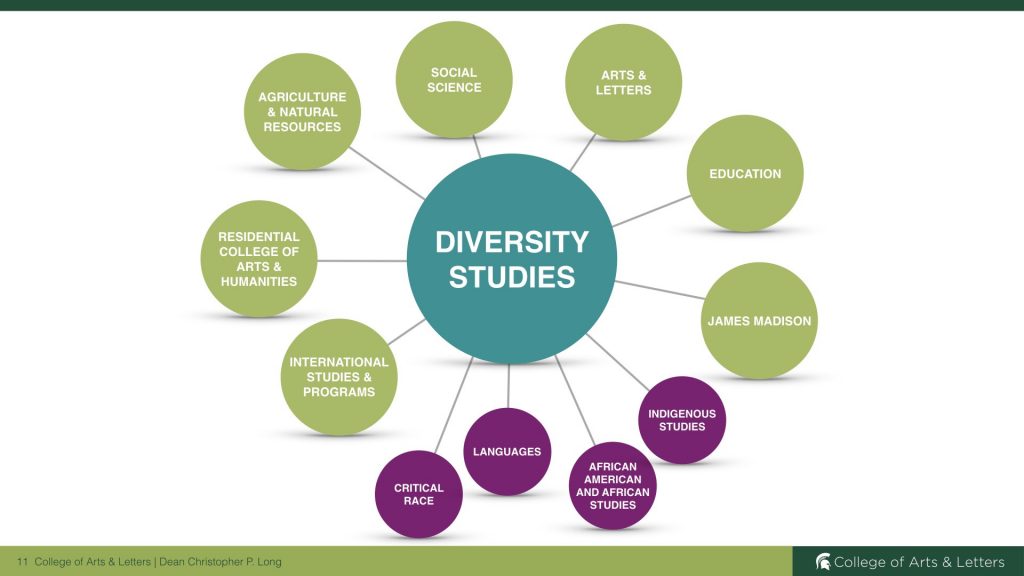
The top priority of the College of Arts & Letters over the past two years has been to establish the new Department of African American and African Studies. The Department was officially approved in February 2019. Our long-standing strength in language science, teaching & learning, and literature & culture is another way we live out our commitment to diversity by deepening our understanding and appreciation of world cultures. Our critical race residencies in the Department of Art, Art History, and Design enrich student experiences and the greater community by facilitating practices of inclusion through art and design, while our Womxn of Color Initiative creates spaces for students to be in conversation with each other and to engage with women of color faculty, guest speakers, staff, and community members. Our American Indian and Indigenous Studies program leads efforts to acknowledge indigenous sovereignty and to hold Michigan State University more accountable to American Indian and Indigenous people. These are all ways we are attempting to live up to our commitment to equity in the College of Arts & Letters.
Weaknesses
Two weaknesses I emphasized in the President’s Council presentation concern the inadequacy of our facilities in the arts and the unacceptable salary inequities between faculty who are and are not in the tenure system.
First, at a time when aspirational, peer, and even regional universities are investing millions of dollars in renovating old buildings or building new ones to support robust initiatives that place the arts at the center of the educational and research missions, we at Michigan State University do not have world-class facilities in the arts to match our world-class faculty in the arts.
These images tell the story:



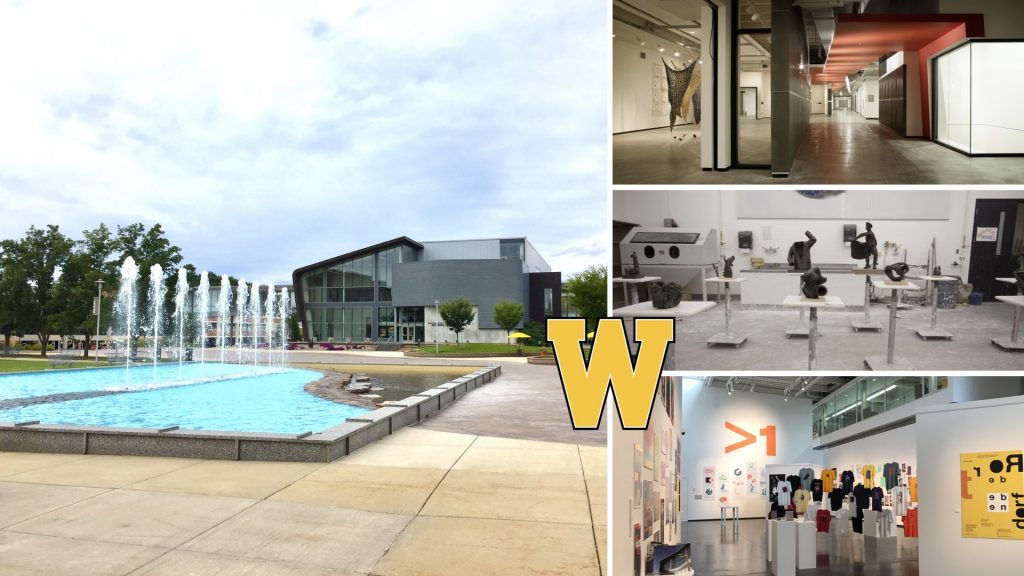


As a result, our facilities in the Kresge Art Center Building and much of the MSU Auditorium are inadequate to support the strengths of our faculty in the Department of Theatre and the Department of Art, Art History, and Design. Without significant investment and coordinated fundraising to transform these facilities, we will remain at a disadvantage when recruiting creative, innovative, and intersectional artists to the College of Arts & Letters.
Second, issues of salary inequity among our faculty prevent us from living up to our core value of equity.

We say we value equity, but what we do is systemically underpay those members of our faculty who are most committed to the teaching mission of the University. This is unacceptable. We must address this inequity if we are serious about creating a culture in which the teaching and research mission of the University are equally valued and deeply integrated.
When we look at the total expenditures of the College of Arts & Letters in relation to the total tuition revenue generated by our College, it becomes very clear that this salary inequity is subsidizing other aspects of the University. If equity is a value and enhancing the undergraduate experience is a priority, this is an urgent problem that must be redressed.
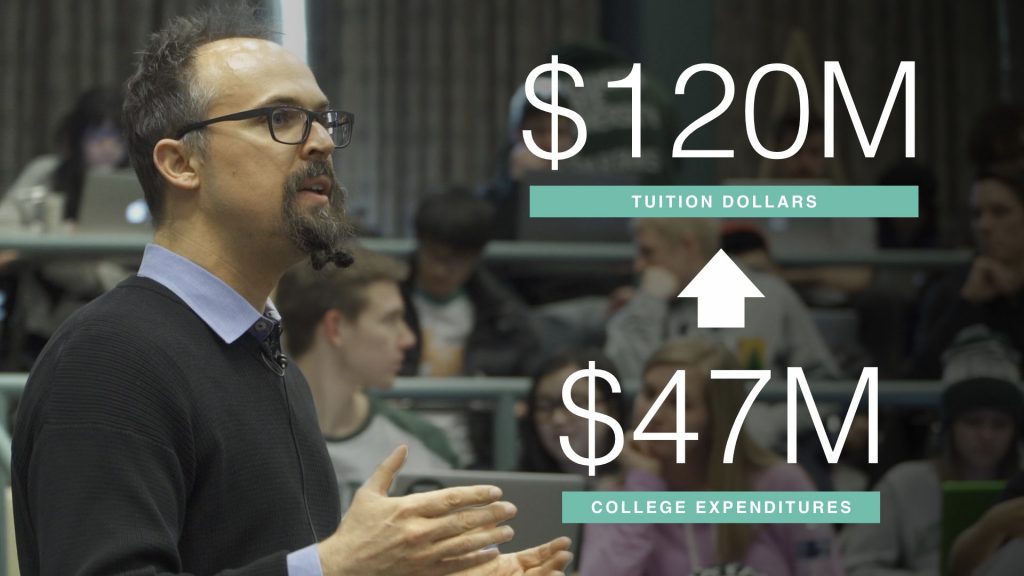
When we look at the total expenditures of the College of Arts & Letters in relation to the total tuition revenue generated by our College, it becomes very clear that this salary inequity is subsidizing other aspects of the university. If equity is a value and enhancing the undergraduate experience is a priority, this is an urgent problem that must be redressed.
In reviewing this portion of the presentation with my colleagues in the College, there was concern that if we are candid with ourselves about the realities of these inequities, we need also to demonstrate a commitment to redressing them. I agree. We have opened a conversation with the College Advisory Committee to consider if we might hold back a higher percentage of whatever general salary increase we might receive next year to begin to address existing salary inequities. A broader strategy, however, will be needed if we are going to address salary inequities among teaching faculty in the union, because those funds come from a source over which deans don’t have control.
Further feedback we received involved the need to be direct and candid about the race and gender inequities that manifest themselves in our College. In attempting to point to some of the ways we are trying to address these issues in the “Strengths” section, I did not have a slide that demonstrated our very real shortcomings in this area. Here are two slides that we perhaps should have included.
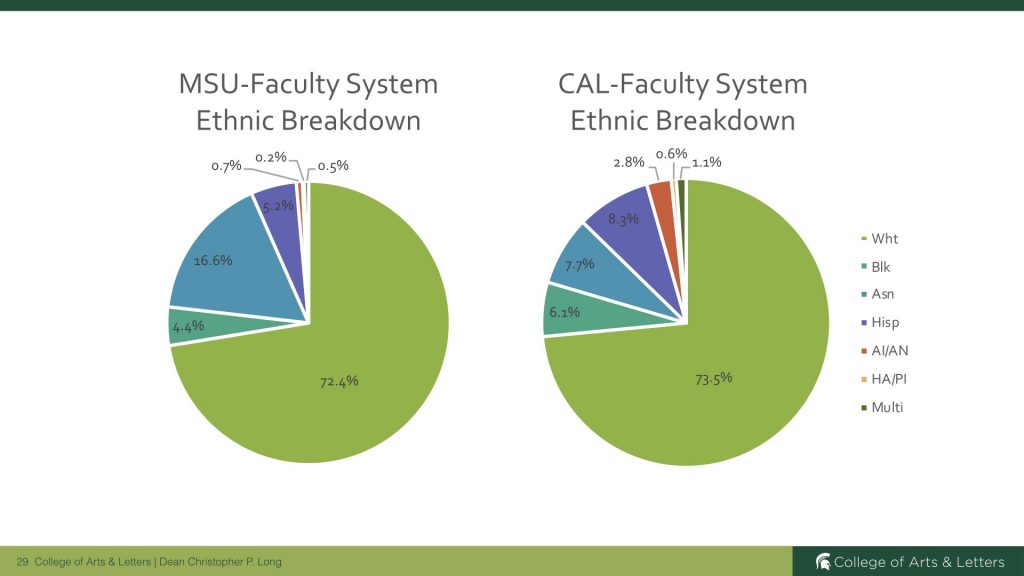
These data indicate that the faculty in the College of Arts & Letters is slightly more white than the University as a whole (73.5% versus 72.4%), and that this difference is largely due to the higher percentage of Asian faculty at MSU (16.6% versus 7.7%) as compared to the College. On the other hand, the College has a higher percentage of African American faculty (6.1% versus 4.4%) and Latinx faculty (8.3% versus 5.2%) than the University as a whole.

The data in this table indicate that we have an emerging majority of women faculty at the Assistant and Associate Professor levels, the Full Professor rank remains majority male.
If we are going to be able to live up to our commitment to equity, we need to practice inclusion as an institutional habit that informs every decision we make.
Threats
In turning to the threats we face in putting our values into practice in ways that will transform the culture of higher education, we have to begin with our massive failure to protect the young people who reported, repeatedly, sexual abuse on the Michigan State University campus.

Will we at Michigan State University have the courage to face our failures honestly and change our institution fundamentally? Will we be able to cultivate the habits of critical self-reflection that are necessary to create a culture that is “open, transparent, trusting, and safe”? Will we challenge incentive systems misaligned with our core values? Will we create a culture of care and accountability capable of redressing the abuse of power? The answers to these questions will determine our ability to put the values we’ve articulated into practice in ways that create the educational community we expect ourselves to be.
However difficult this first threat is, we in the arts and humanities also face a broader cultural threat that undermines our ability to weave creativity and meaning into the life of the University. One way to gain some purchase on the marginalization of the arts and humanities in the broader national context is to look at the disparity between federal funding for the arts and humanities versus STEM fields.

No one would deny that the cost of STEM research is exponentially larger than that of research and creative activity in the arts and humanities. Further, these data already reflect an ill-considered reduction of funding for the National Science Foundation (NSF) and the National Institutes of Health (NIH) over the past few years. Even so, the disparity reflected on the slide above is powerful testimony to our collective disinterest in supporting artistic and humanistic endeavors that deepen our understanding of the world we share and enriching the texture of our relationships with one another.
In the College of Arts & Letters at Michigan State University, we see the effects of the broader cultural emphasis on STEM and pre-professional fields manifest themselves in the decline of our majors over the past four years.


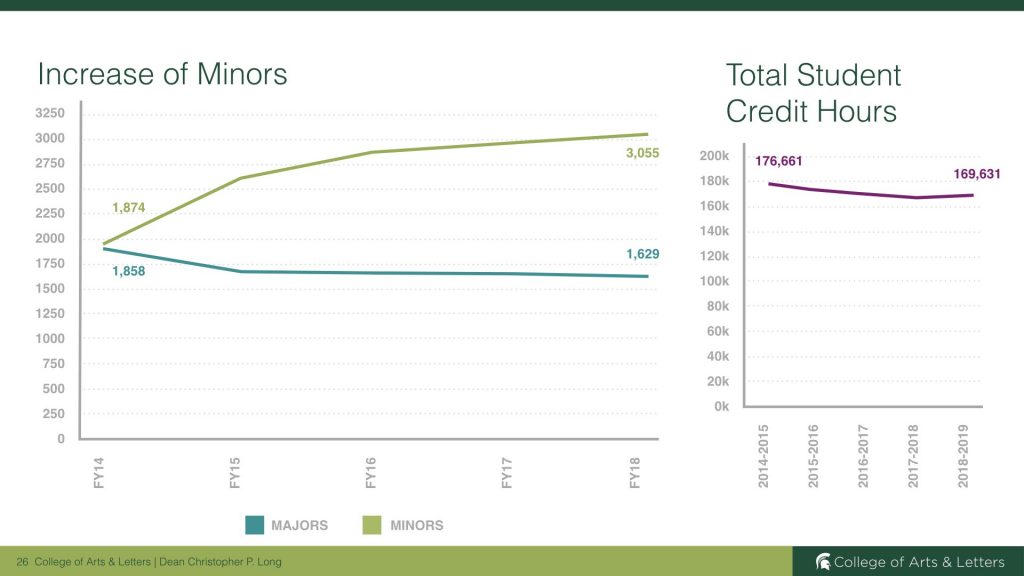
However, as the above graphs suggest, although we have experienced a decline in majors, we have seen a rapid increase in the number of students minoring in the arts and humanities. This suggests to me that a broad range of students across the University continue to look for ways to integrate into their academic lives the creative arts and opportunities to consider the broader questions of meaning introduced by the humanities. Further, our fastest growing majors are in Graphic Design (133 students) and Experience Architecture (128 students). We have only experienced a slight decline in overall student credit hours over the past four years, and we hope that our values-based efforts at curriculum reform will bring more students to the College as majors.
Opportunities
Despite the threats and weaknesses we have identified, indeed, in part precisely because of our willingness to face them, we are well positioned to play a leadership role in four important opportunities that lie before us.
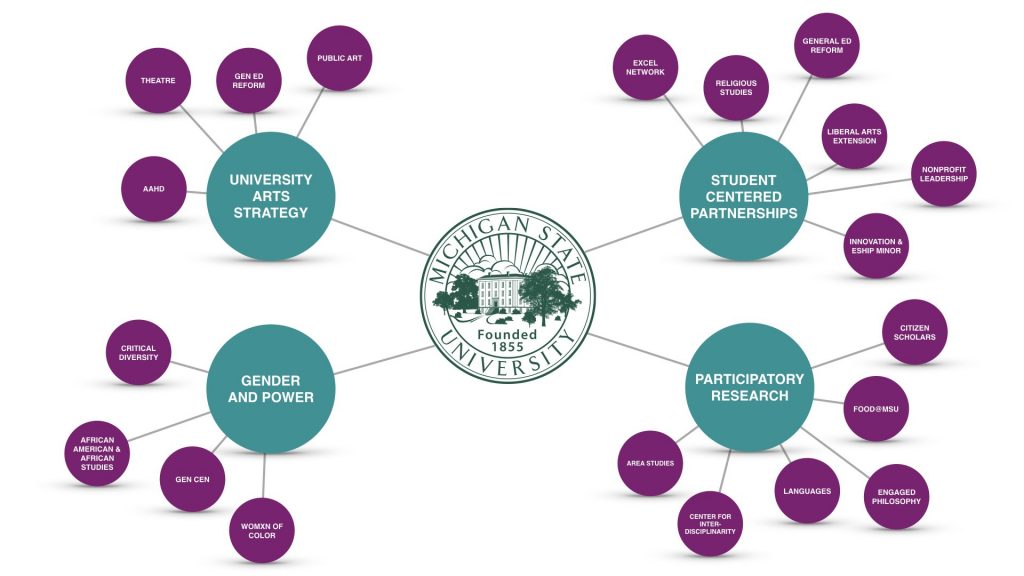
The MSU Arts Strategy offers us an opportunity to integrate the arts into the fabric of the teaching and research mission of the University. Implementing this bold plan which was developed over the past two years would enable us to revitalize our arts facilities, reshape our curriculum, and position the arts as a catalyst of creativity and collaboration regionally, nationally, and internationally.
In the Spring semester of 2018, a number of Deans proposed the creation of a Gender and Power Institute that would advance new knowledge in the intersectional dynamics of gender, race, and power in national and international contexts; design and empower innovative approaches to the understanding and prevention of gender-based violence; and create transdisciplinary education opportunities and experiences for undergraduate and graduate students. We have an important opportunity to advance the Gender and Power Institute as a University research priority.
The public orientation and land-grant mission of MSU requires us to take a leadership role in modeling practices of participatory research in which members of communities are engaged as co-equal partners in the creation of research that impacts our communities. A deep understanding of language and culture is critical to any participatory research design, and we have an enormous opportunity to integrate the expertise of our language faculty with that of our scientists as we engage communities in making meaningful change. Our Center for Interdisciplinarity has been at the heart of our efforts to weave practices of participatory research into the life of the University.
Finally, our student success initiatives afford us an opportunity to think holistically and to work collaboratively to provide our students with the experiences they need to thrive in an interconnected, intersectional 21st century world.
To be successful, however, these four opportunities will need to be priorities for the whole University, for they will only be successful if we bring the full weight and power of the broad range of disciplines and resources we have at the University to bear on them. We in the College of Arts & Letters are prepared to facilitate our success by playing both leadership and supporting roles. If, however, we are going to be successful, we will all need to be intentional about pursuing these initiatives by putting into practice our commitment to “creating a culture that is transparent, open, trusting, and safe; cultivating caring and accountable leadership; and empowering everyone to be engaged in a community that is inclusive and equitable.”
This returns us to a passage from the July 2018 Op-Ed that eight deans wrote for Inside Higher Education in which we articulated the pathway toward the culture change in higher education we need.
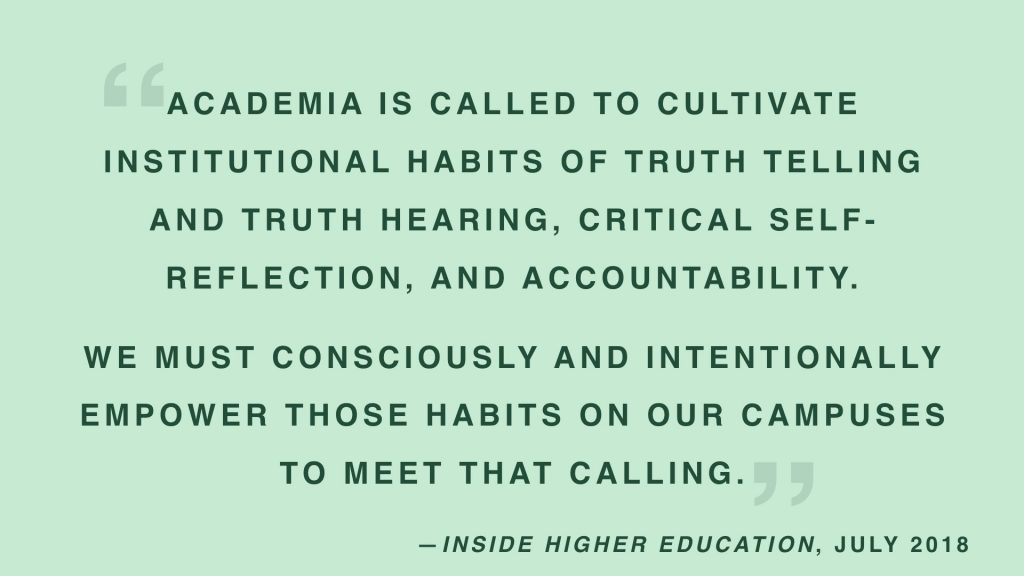
Acknowledgements
Publishing this post required an intentional commitment to embody the values articulated in the presentation itself. To that end and with equity, openness, and community in mind, I consulted with a wide group of faculty in the College of Arts & Letters, including members of the College Advisory Committee and the Dean’s Arts Advisory Council. I am grateful for their insights, suggestions, and encouragement.
In particular, I would like to thank Jeff Wray, Karin Zitzewitz, Sonja Fritzsche, Bill Hart-Davidson, Cara Cilano, Ryan Kilcoyne, Joshua Morey, Kim Popiolek, Leann Dalimonte, Joe Salem, Ron Hendrick, and Valerie Long. I take full responsibility for the content of this post, but am grateful to have colleagues and friends who are steadfast in giving me their best judgment as we attempt to put our values into the practices of leadership that shape the life of the College of Arts & Letters.


One Comment